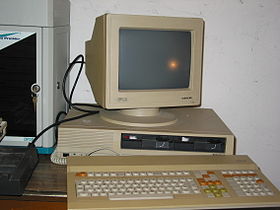Siemens PC-D
 | |
| Type | Personal computer |
|---|---|
| Release date | PC-X: 1982 PC-D: 1984 |
| Discontinued | 1986 |
| Media | 5¼″ floppy disk, hard disk |
| Operating system | PC-X: SINIX, PC-D: MS-DOS 2.11 |
| CPU | Intel 80186 @ 8 MHz[1] |
| Memory | 128 KB – 1 MB |
| Successor | PCD-2 |
The PC-D and PC-X were personal computers sold by Siemens between 1982 (PC-X)/1984 (PC-D) and 1986. The PC-D was the first MS-DOS-based PC sold by Siemens, though it was not fully compatible with the IBM PC architecture. It was succeeded by the PCD-2.[2]
Hardware
Most of the hardware was identical. While the PC-X was equipped with 1 MB of RAM, a hard disk and a MMU, the PC-D came with 128 kB of RAM and a single 5¼″ floppy disk drive in its basic configuration.[1][3] More powerful configurations with 256 kB, 512 kB or 1 MB and either a second floppy disk drive or a hard disk with a capacity of 13 or 20 MB were also available.[1][4] The keyboard layout differed between the two models.
The PC-D had a certain level of compatibility with the IBM PC architecture but differed in a number of aspects:
- Intel 80186 processor[1]
- Double-density floppy disk drives with a proprietary 80-track format (729,088 bytes)[1]
- Proprietary monochrome graphics adapter with a resolution of 640×350 pixels and black-on-white text mode (which could be inverted through a software tool)[1][3]
- 12″ monochrome monitor, powered through the graphics card
- V.11 serial ports for keyboard and mouse (the latter being optional)[1]
- Different keyboard layout: among others, the PC-D had a Help key and keys to control a connected printer but only five cursor keys (←↓↑→ and Home)[1]
- Both V.11 and V.24 ports for printers[1]
- A parallel port was available only as an add-on; if not installed, LPT1: and LPT2: would address the serial ports
- Proprietary VG96 Local Bus
- The power switch could be inhibited in software
- A debug button (located next to the reset button) to display the contents of the processor registers
- The mainboard had a SCSI interface, although hard disks had a ST506 interface and were connected to a separate controller board.
Optional hardware included:
- a two-button mouse[5]
- the PT20 daisy wheel printer, the PT88 (available as ink jet or pin printer) or the PT89 (the A3 variant of the PT88)[4][5]
- the UTC 101, UTC 421-1 or UTC 424-4 teletex controllers, the latter of which could also be used to network up to four PC-Ds[4][5]
- a tape drive with a capacity of 45 MB[4]
Software
The PC-D shipped with MS-DOS 2.11[1][3] (version 3.20 became available later), which was extended with a menu system through which users could launch applications without having to use the command line.[1] Application software included:
- Microsoft Word[6]
- Microsoft Multiplan[7]
- Microsoft Chart[8]
- dBase,[9]
- GW-BASIC interpreter[10] and compiler
- Lotus Spotlight, an application suite which consisted of a notepad, calculator, calendar, card file, phone book and file manager which could be launched on top of other running DOS applications[11]
- Open Access, an office suite which included a database, a spreadsheet application, a charting tool, a calendar and a BBS terminal[12]
- A 9750 terminal emulation for BS-2000 mainframe access[4]
- Some simple games
- Microsoft Windows 1.0
Hardware calls on the PC-D differed from those on fully IBM compatible PCs, causing most DOS applications to crash on the PC-D unless they were recompiled or patched, making them incompatible with IBM PCs. Windows applications could usually be exchanged between both platforms.
The PC-X shipped with SINIX.
References
- ^ a b c d e f g h i j k Siemens PC-D. Technische Daten. (German)
- ^ "Elmars Virtuelles Computer Museum" (in German).
- ^ a b c Siemens PC-D. Betriebssystem MS-DOS. (German)
- ^ a b c d e PC-D Hardware-Übersicht (German)
- ^ a b c Siemens PC-D (German)
- ^ Siemens PC-D. Textverarbeitung. (German)
- ^ Siemens PC-D. Tabellenkalkulation. (German)
- ^ Siemens PC-D. Bürografik mit CHART. (German)
- ^ Siemens PC-D. Datenverwaltung. (German)
- ^ Siemens PC-D. Programmieren in GW-BASIC. (German)
- ^ Siemens PC-D. Spotlight. (German)
- ^ Siemens PC-D. Open Access. (German)
